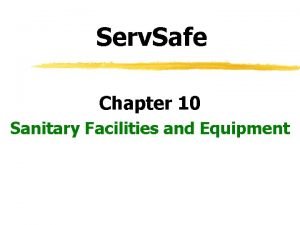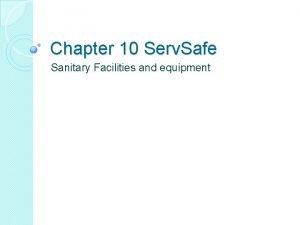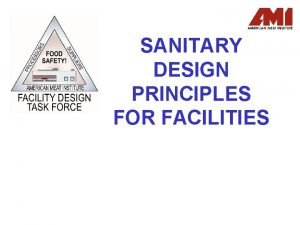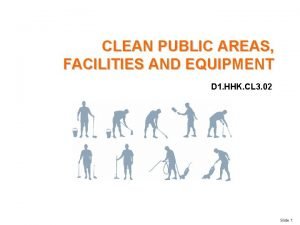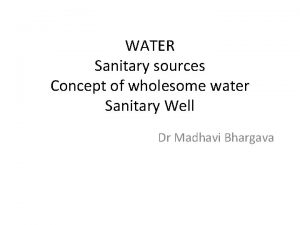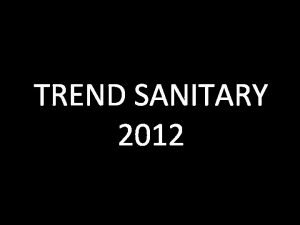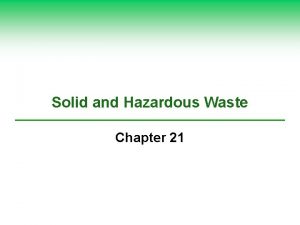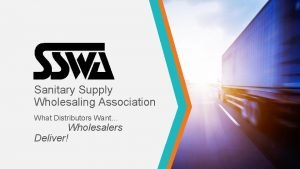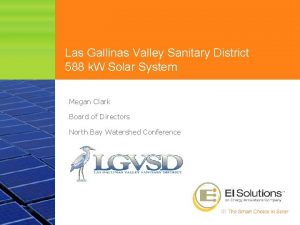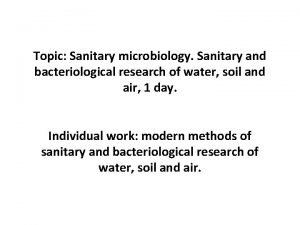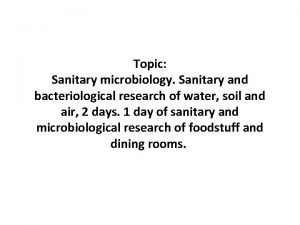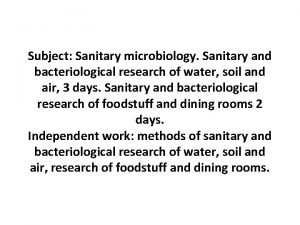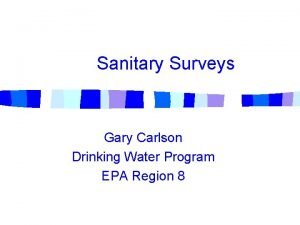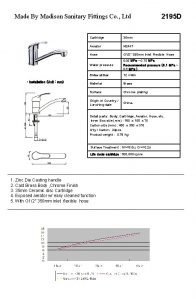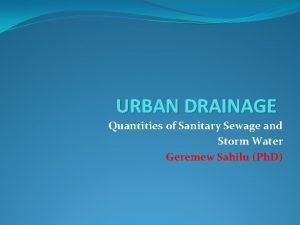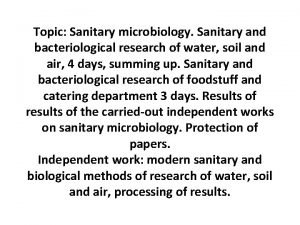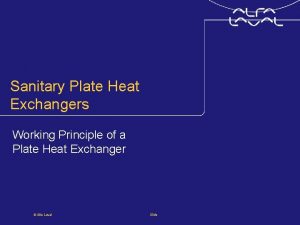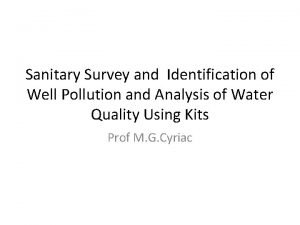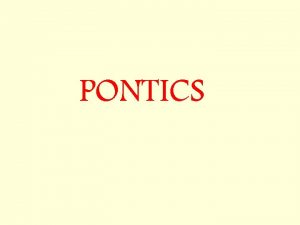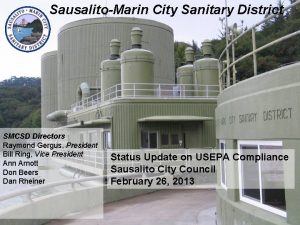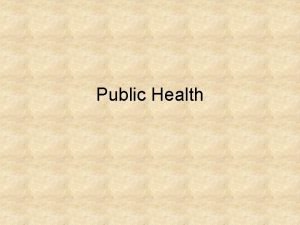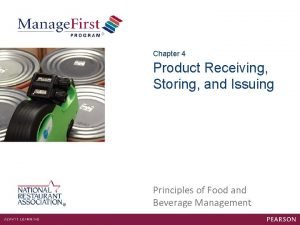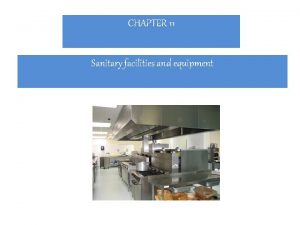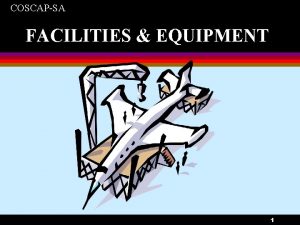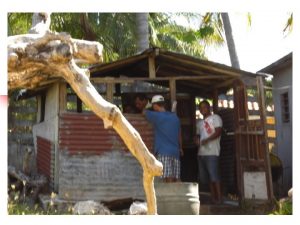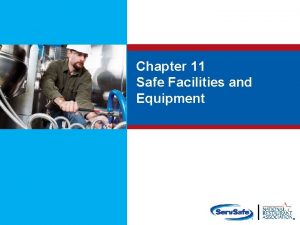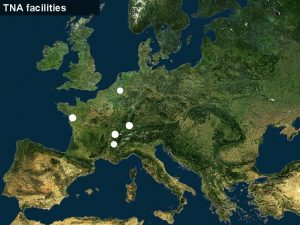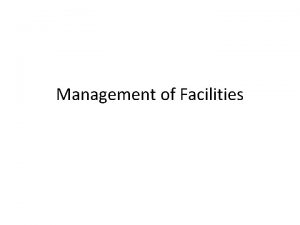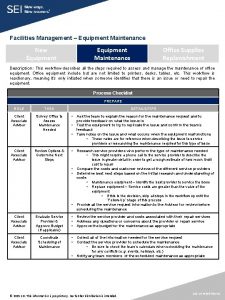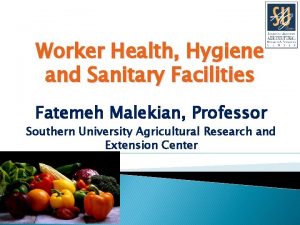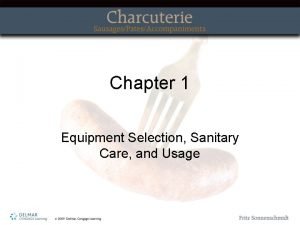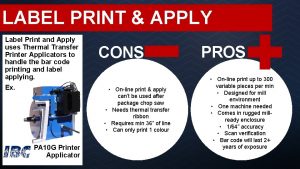Sanitary Facilities and Equipment 11 1 Apply Your





























- Slides: 29

Sanitary Facilities and Equipment 11 -1

Apply Your Knowledge: Test Your Food Safety Knowledge 1. True or False: A hose attached to a utility-sink faucet and left sitting in a bucket of dirty water could contaminate the water supply. 2. True or False: There must be a minimum of twenty footcandles of light (215 lux) in a food preparation area. 3. True or False: Handwashing stations are required in dishwashing and service areas. 4. True or False: When mounted on legs, stationary equipment must be at least two inches (five centimeters) off the floor. 5. True or False: Grease on an establishment’s ceiling can be a sign of inadequate ventilation. 11 -2

Designing or Remodeling a Facility: Kitchen Layout A well-designed kitchen will address: n Workflow n It must minimize the amount of time food spends in the temperature danger zone n It must minimize the number of times food is handled 11 -3

Designing or Remodeling a Facility: Kitchen Layout A well-designed kitchen will address: continued n n Contamination n The risk of cross-contamination must be minimized n Dirty equipment should not be placed where it will touch clean equipment or food Equipment accessibility n All equipment must be easily accessible for cleaning 11 -4

Designing or Remodeling a Facility: The Plan Review Design plans may require approval by: n The local regulatory agency n The zoning or building department The plan should include: n A proposed layout and mechanical plans n Type of construction materials to be used n Types or models of proposed equipment n Specifications for utilities, plumbing, and ventilation 11 -5

Materials for Interior Construction: Flooring When selecting flooring, consider the porosity of the material: n Porosity is the extent to which a material will absorb liquids n Flooring that is highly porous (absorbent) should be avoided since it: n Creates an ideal environment for microorganisms n Can cause slips and falls n Can become easily damaged 11 -6

Materials for Interior Construction: Flooring Nonporous flooring should be used in: n Walk-in refrigerators n Food-preparation areas n Dishwashing areas n Restrooms n Other areas subject to moisture, flushing, or spray-cleaning 11 -7

Nonporous Resilient Flooring Includes: n Rubber tile n Vinyl tile Advantages: n Relatively inexpensive n Can withstand shock n Easy to clean and maintain n Capable of handling heavy traffic n Resistant to grease and alkalis n Easy to repair or replace 11 -8

Hard Surface Flooring Includes: n Quarry and ceramic tile n Brick n Terrazzo and marble n Hardwood Advantages: n Nonabsorbant n Very durable n Excellent choice for restrooms and high-soil areas 11 -9

Special Flooring Needs Coving: n A curved, sealed edge placed between the floor and wall n It eliminates sharp corners or gaps that would be impossible to clean n It must adhere tightly to the wall to: n Eliminate hiding places for pests n Prevent moisture from deteriorating the wall 11 -10

Handwashing Stations Handwashing stations must be conveniently located and are required in: n Restrooms n Food-preparation areas n Service areas n Dishwashing areas 11 -11

Handwashing Stations Handwashing stations must be equipped with: n Hot and cold running water n Liquid, bar, or powdered soap n A means to dry hands n A waste container n Signage indicating employees must wash hands Handwashing Signage Handwashing Disposable Towels Signage Soap Warm-Air Dryer Hot & Cold Water Waste Container 11 -12

Apply Your Knowledge: What’s Missing? What’s missing from this handwashing station? 11 -13

Sanitation Standards for Equipment: Surfaces Purchase equipment with foodcontact surfaces that are: n Safe and durable n Corrosion resistant n Nonabsorbent n Sufficient in weight and thickness to withstand repeated cleaning n Smooth and easy to clean n Resistant to pitting, chipping, scratching, and decomposition 11 -14

Sanitation Standards for Equipment: NSF and UL Look for the following marks when purchasing equipment: n n NSF International mark: Equipment has been evaluated, tested, and certified as meeting international commercial food equipment standards Underwriters Laboratory (UL) marks: Equipment is in compliance with NSF standards or UL’s own environmental and public health (EPH) standards 11 -15

Selecting and Installing Dishwashing Machines When selecting and installing dishwashing machines: n Water pipes to the machine should be as short as possible to prevent heat loss n Install the machine at least 6 inches (15 centimeters) off the floor to permit easy cleaning underneath n Post information regarding water temperature, conveyor speed, and chemical concentration on or near the machine n Position the machine so its thermometer is readable 11 -16

Installing Stationary Equipment Stationary equipment should be: n Mounted on legs at least 6 inches (15 centimeters) off the floor OR n Sealed to a masonry base Legs 6” Min. Floor Masonry Base Sealant 11 -17

Installing Stationary Tabletop Equipment Stationary tabletop equipment should be: n Mounted on legs with a minimum -inch (10 centimeter) clearance between the equipment base and tabletop 4 OR n The equipment should be tiltable or sealed to the countertop with a foodgrade sealant 11 -18

Cantilever-Mounted Equipment Cantilever-mounted equipment is: n Attached to the wall or to a mount with a bracket n Easier to clean underneath and behind 11 -19

Maintaining Equipment Once equipment has been properly installed: n It must receive regular maintenance n It must be maintained by qualified personnel n Follow the manufacturers’ recommended maintenance schedule 11 -20

Water Supply Acceptable sources of potable water include: n Approved public water mains n Regularly tested private sources n Bottled drinking water n Closed, portable water containers filled with potable water n Water in on-premise water-storage tanks n Water transport vehicles that are properly maintained 11 -21

Water Supply: Interruption If the water supply is interrupted: n Use bottled water n Boil water (if allowed) n Purchase ice n Use boiled water for handwashing and essential cleaning n Consider usingle-use items to minimize dishwashing 11 -22

Plumbing Only licensed plumbers should: n Install plumbing systems n Install grease traps n Repair leaks from overhead pipes 11 -23

Plumbing: Cross-Connections and Backflow Cross Connection n Physical link through which contaminants from drains, sewers, and other wastewater sources can enter the potable water supply Backflow n Reverse flow of contaminants through a cross-connection into the potable water supply 11 -24

Plumbing: Backflow Prevention Methods Vacuum breaker Air gap Air Gap Flood Rim Air Gap 11 -25

Sewage A backup of raw sewage is cause for: n Immediate closure n Correction of the problem n Thorough cleaning 11 -26

Lighting To prevent lighting from contaminating food, use: n Shatter-resistant light bulbs n Protective covers made of metal mesh or plastic n Shields for heat lamps 11 -27

Ventilation Systems: n If adequate, there will be little buildup of grease and condensation on walls and ceilings n Hoods, fans, guards, and ductwork must not drip onto food or equipment n Hood filters and grease extractors must be cleaned regularly n Hoods and ductwork must be cleaned periodically by professionals 11 -28

Garbage Disposal Garbage: n Should be removed from foodpreparation areas as quickly as possible to prevent pests and contamination n Should not be carried above or across food-preparation areas. 11 -29
 Servsafe chapter 10
Servsafe chapter 10 Sanitary facilities and equipment
Sanitary facilities and equipment Cross apply vs outer apply
Cross apply vs outer apply 10 principles of sanitary design
10 principles of sanitary design Cleaning public areas facilities and equipment
Cleaning public areas facilities and equipment Sanitary landfill advantages and disadvantages
Sanitary landfill advantages and disadvantages Give us your hungry your tired your poor
Give us your hungry your tired your poor Parapet wall sanitary well diagram
Parapet wall sanitary well diagram Trend sanitary
Trend sanitary Sanitary landfill
Sanitary landfill Sanitary supplies wholesaler
Sanitary supplies wholesaler Las gallinas valley sanitary district
Las gallinas valley sanitary district Pontic and retainer
Pontic and retainer Sanitary microbiology
Sanitary microbiology Microbiology
Microbiology Sanitary microbiology
Sanitary microbiology Epa sanitary survey
Epa sanitary survey Castelli sanitary
Castelli sanitary Factors affecting sanitary sewage
Factors affecting sanitary sewage Sanitary microbiology
Sanitary microbiology Sanitary plate
Sanitary plate Sanitary registration in el salvador
Sanitary registration in el salvador Sanitary survey
Sanitary survey Flat back pontic
Flat back pontic Sanitary landfill
Sanitary landfill Pasco sanitary landfill
Pasco sanitary landfill Sausalito marin city sanitary district
Sausalito marin city sanitary district The sanitary report 1842 bbc bitesize
The sanitary report 1842 bbc bitesize Storing and issuing
Storing and issuing Hotel sizes classifications
Hotel sizes classifications
